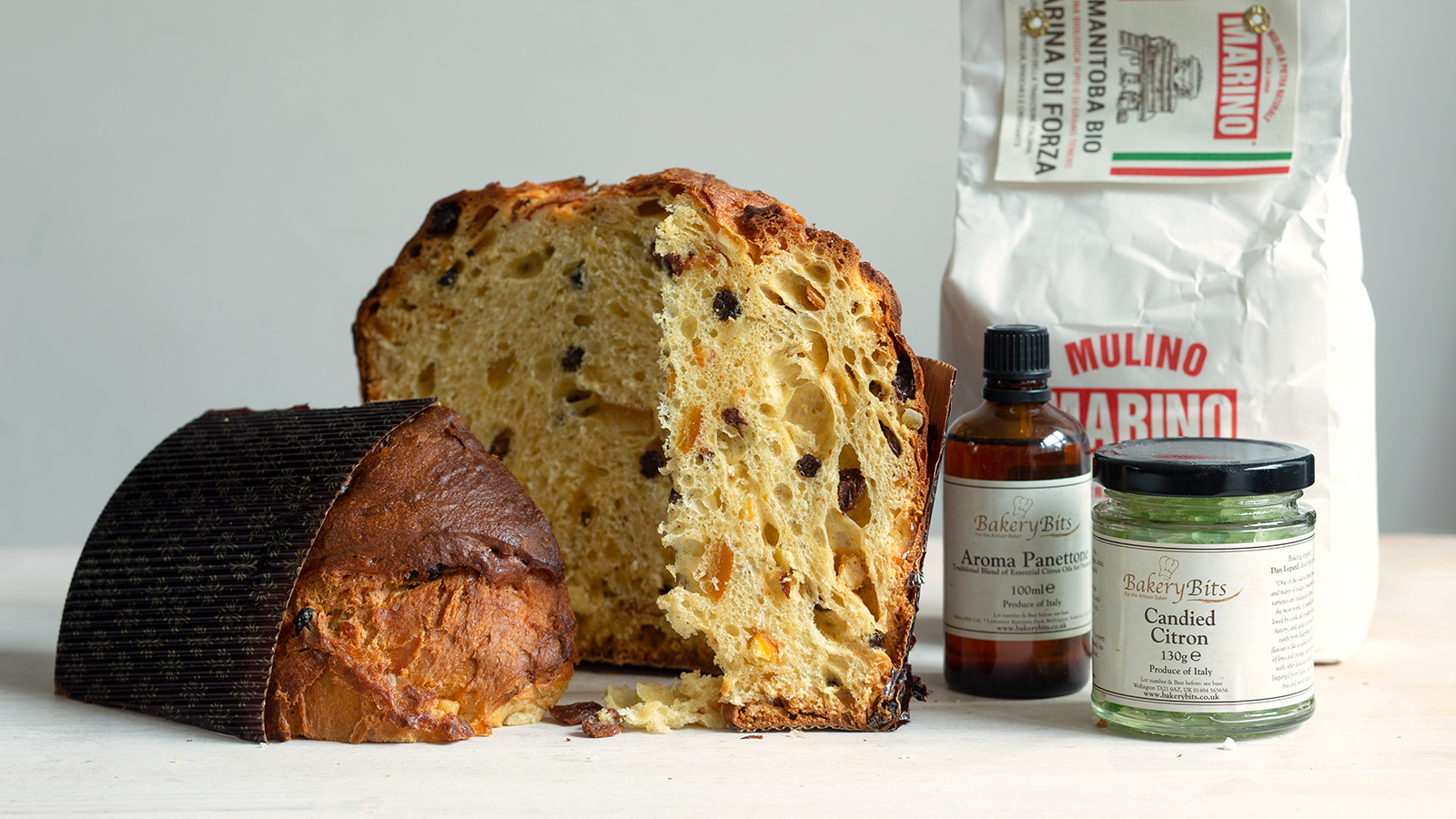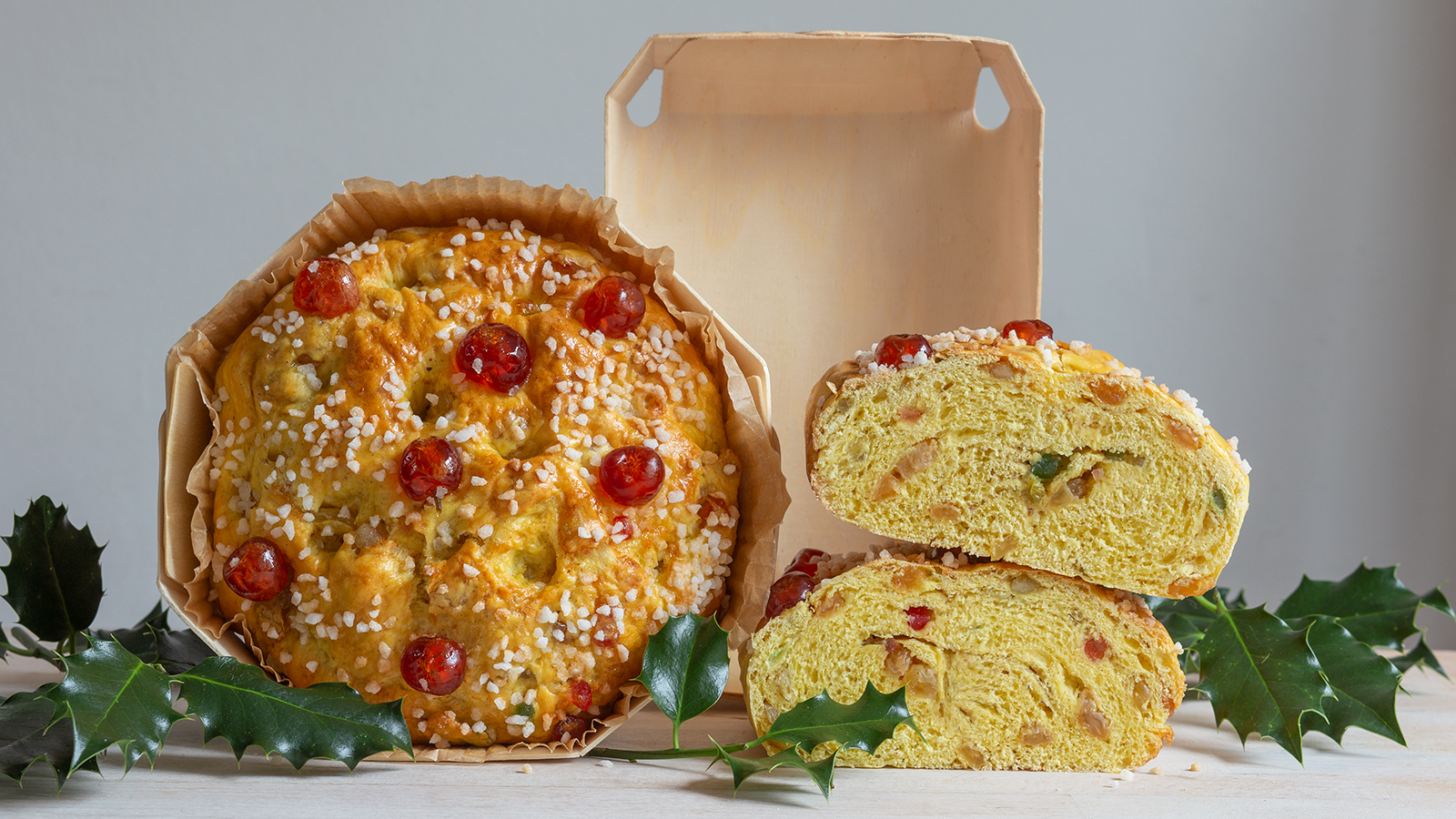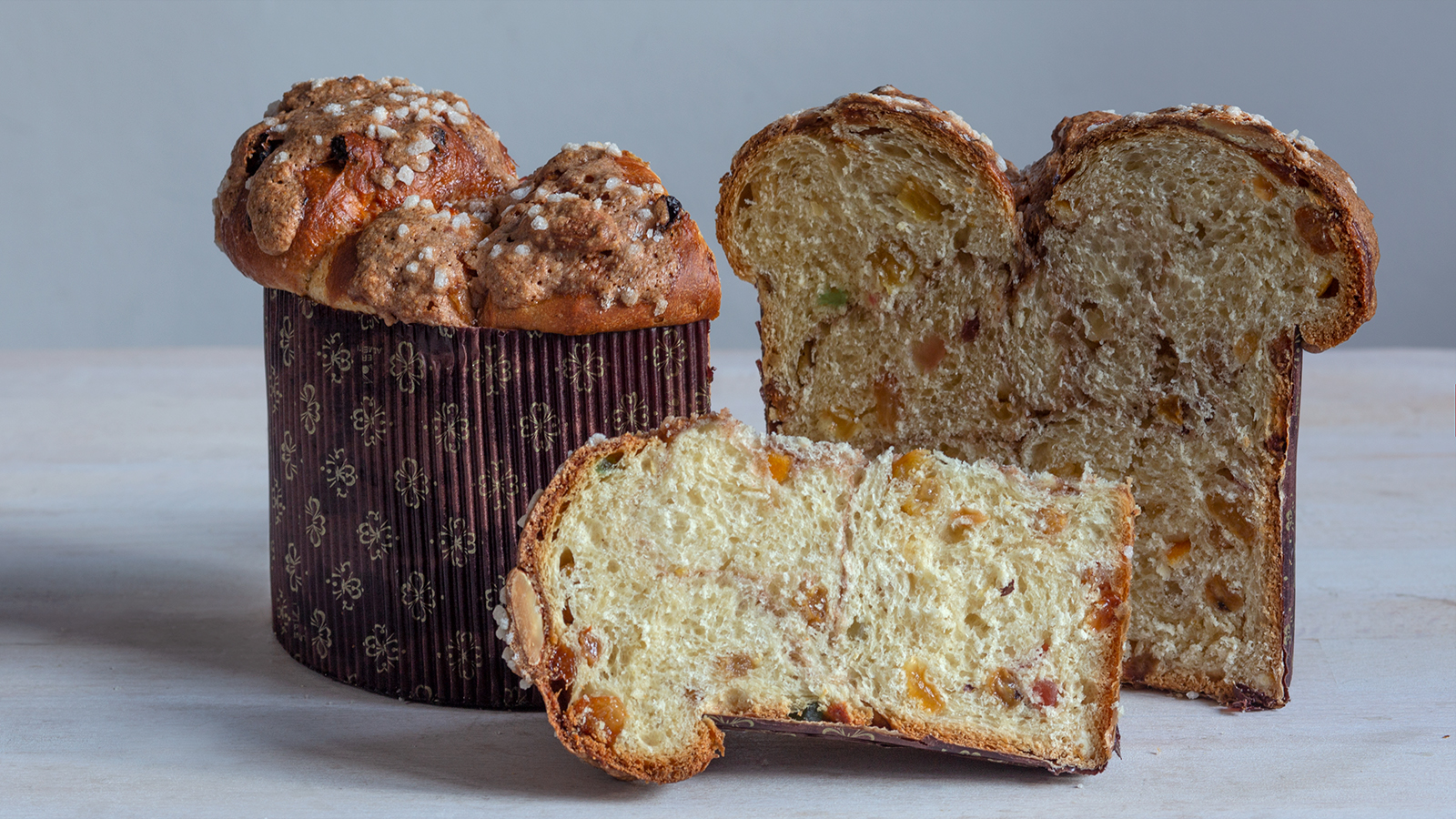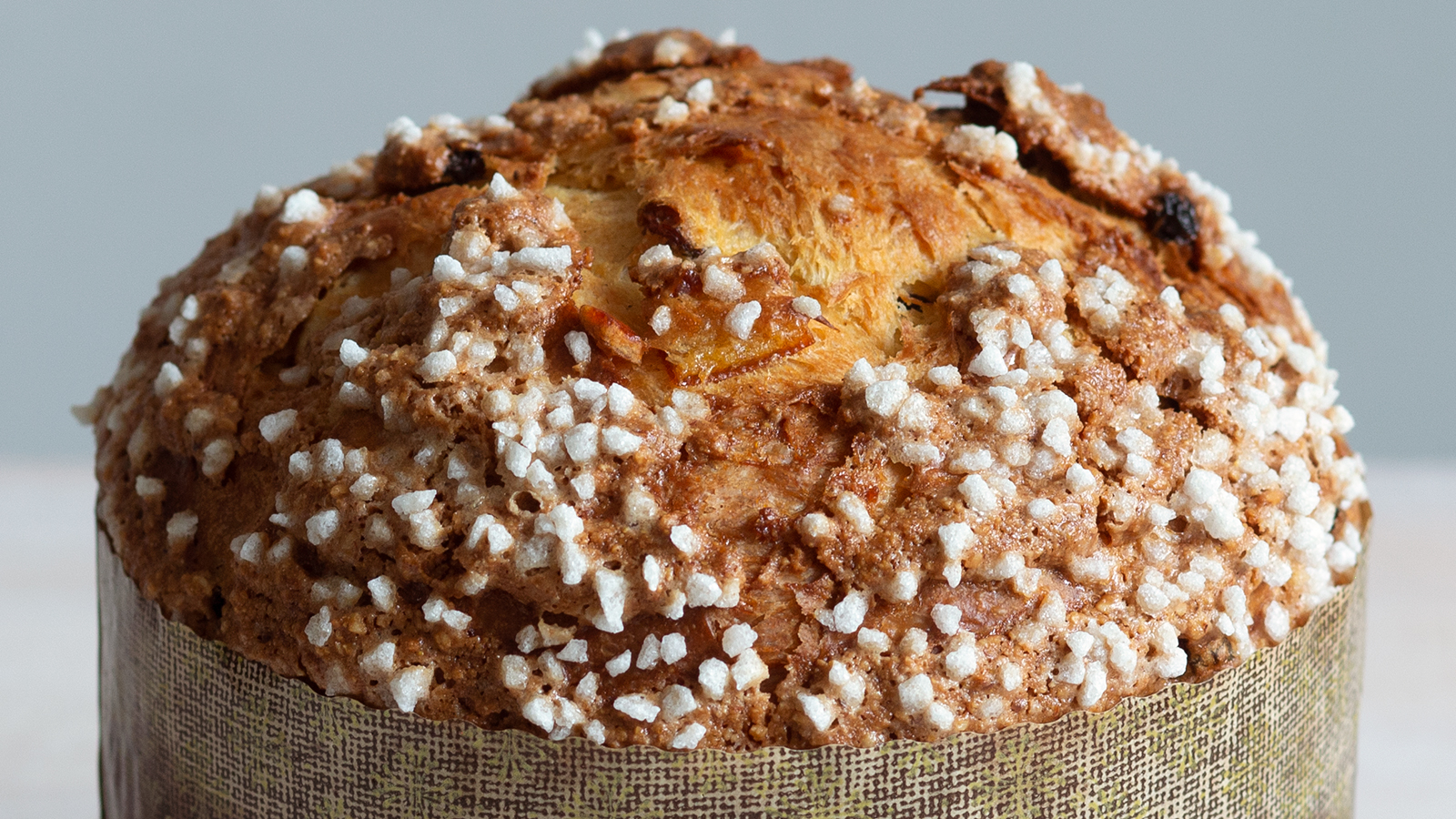Ingredients
for the pasta madre with commercial yeast
50g warm water, about 25C
1g Saf-Gold Instant Osmotolerant Yeast
100g Organic Type "0" Furia (Manitoba) Flour
for the biga
all of the pasta madre, plus
100g cold water, about 10C
30g caster sugar, golden is good
220g Organic Type "0" Furia (Manitoba) Flour
30g unsalted butter
for the final dough
all the biga, plus
30g cold water, about 10C
60g Organic Type "0" Furia (Manitoba) Flour
40g caster sugar, golden is good
130g egg yolk (from about 7 eggs)
35g Black Bee Honey
1g BakeryBits Madagascan Whole Pod Vanilla Powder
5g Aroma Panettone Essential Oil
6g salt
60g unsalted butter
240g dried fruit, a mixture of raisins and BakeryBits candied peel
the topping
¼ batch panettone “glassa”
10g BakeryBits panettone sugar
8 whole unskinned almonds
 This version of panettone I’ve written for you here follows Massari’s now-classic methods, from his & Zoia’s landmark book on sweet dough making, Cresci: The Art of Leavened Dough, but uses commercial yeast as a base for the mother dough. Massai describes this sort of yeasted method as a very respectable alternative to the one made with natural leaven (known as Lievito Naturale, Pasta Lievitata, or Pasta Madre aka “mother dough”). It does not have quite the same texture, flavour and long-lasting softness as the natural leaven kind, but in its favour it makes a beautiful sweet bread relatively quickly. Ok, you will still need to devote three days for making it but in the world of artisan panettone making that’s a moment’s effort. Think of it as your first steps in learning the techniques to panettone excellence. From this you can progress to making your own pasta madre naturale from scratch, and on to the varied recipes from the great panettone bakers of Italy, and now, the world, and become captivated by the craft of sweet dough making Italian-style.
This version of panettone I’ve written for you here follows Massari’s now-classic methods, from his & Zoia’s landmark book on sweet dough making, Cresci: The Art of Leavened Dough, but uses commercial yeast as a base for the mother dough. Massai describes this sort of yeasted method as a very respectable alternative to the one made with natural leaven (known as Lievito Naturale, Pasta Lievitata, or Pasta Madre aka “mother dough”). It does not have quite the same texture, flavour and long-lasting softness as the natural leaven kind, but in its favour it makes a beautiful sweet bread relatively quickly. Ok, you will still need to devote three days for making it but in the world of artisan panettone making that’s a moment’s effort. Think of it as your first steps in learning the techniques to panettone excellence. From this you can progress to making your own pasta madre naturale from scratch, and on to the varied recipes from the great panettone bakers of Italy, and now, the world, and become captivated by the craft of sweet dough making Italian-style.
Mixing the dough until it is incredibly elastic, and maintaining a very warm temperature for much of the rising, are both vital for success. Here I recommend some serious gear: the very powerful IGF Fornitalia Tabletop Spiral Mixer sold here at BakeryBits as well as the Brød & Taylor Folding Proofer & Slow Cooker. The panettone pictured here was made using this equipment and made success much more straight forward and achievable.
For the pasta madre with commercial yeast
Add the water to a small bowl, dissolve the yeast in it then add the flour and mix to a very stiff dough. Leave this 10 minutes, covered, then knead it until very smooth. Place in a bowl, cover and leave at 24C for about 6 hour or until tripled in volume.
for the biga
Place the pasta madre, water, sugar and flour in the mixing bowl and work until very smooth and quite well-developed. Add the butter and mix until very elastic. Round the dough into a ball and leave to rise at 26C-28C for about 7 hours or until almost tripled in volume (slightly less is ok, there still should be some elasticity in the biga).
for the final dough
Put the biga in the mixing bowl with the water and flour then mix slowly until it starts to come together. Beat in the sugar until dissolved, add in a third of the egg yolk and beat until almost smooth then add then the flavourings - honey, vanilla, panettone oil - and beat until mixed through. Add the remaining yolk slowly until mixed through, add the salt and beat well, then add the softened butter and mix until very smooth and very elastic. Add the dried fruit and mix very gently on a slow speed until combined. Remove the dough from the mixing bowl, and place on an oiled surface for one hour to very-slightly rise. Then shape the dough into a ball, oiling your hands is helpful here, then place the rounded dough in a 1kg panettone case. Leave to rise at 27C-30C for about 6-7 hour or until tripled in height.
To finish and bake
You can either cut a cross with a lame in the top and place a few thin piece of additional butter in the cuts to help it open. Or make a ground almond “glassa” and spread this over the top, mixed with a few whole almonds, and sprinkle nibbed sugar on top.
Heat the oven to 150C fan and bake for about 50 minutes or until the temperature probe in the core reached 85C (it will rise to 90C in the first 10 minutes after removing it from the oven, as the temperature from the crust heats the middle further). While it is baking have two towers ready (I use stacks of books while I’m trialling it) and strong metal panettone prongs ready to pierce the base. Remove the panettone from the oven when it’s baked and immediately spear the metal prongs through the base of the case. Invert the panettone immediately, carefully, then place on the towers and leave undisturbed until cold the following day.















